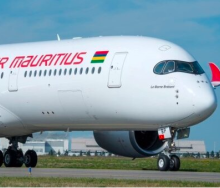Africa accounts for just 1,9% of global passenger and cargo traffic, mainly because of the lack of intra-Africa connectivity and market access.
Kamil Alawadhi, Iata’s Regional VP Africa and Middle East, defined some of the priority issues that need to be addressed to make Africa’s airline industry sustainably viable. He was speaking to the 2022 General Assembly of the African Airlines Association (AFRAA) in Dakar, Senegal, in December.
“Connectivity is precious. The pandemic demonstrated that everybody suffers when aviation stops. It also dispelled the myth that flying only benefits the rich. A financially viable air transport sector in a fit-for-purpose and enabling regulatory environment supports jobs, promotes transformation and will be a driving force for Africa’s economic recovery and future growth,” said Alawadhi.
Africa’s airlines are on track to post a combined US$638 million (R10,8bn) loss this year (2022-2023), with demand still 32,3% lower than 2019, and capacity 31,1% off the 2019 mark.
“Nevertheless, in the face of macro-economic headwinds and the increased vulnerability of several African economies, the continent’s airlines should reduce these losses by about two-thirds, falling to $213 million (R3,6bn) next year. We see this being driven by a 27,4% rebound in passenger traffic and capacity increasing by 21,9%. By the time we gather for the 2023 AFRAA assembly, traffic should have recovered to 86% of pre-COVID levels,” said Alawadhi.
Regional challenges
Africa’s airlines are experiencing unprecedented load factors and many are operating at, or near to, maximum capacity. Yet, it has its own regional challenges, which are priorities:
1. Connectivity, market access and regulatory reform
Concerning the Single African Air Traffic Market (SAATM), he said fifth freedom traffic rights were the most visible and attractive component of SAATM, but the devil was in the detail. “Not only do we require a common understanding of what these market freedoms are, but also of how they are to be applied and administered. It requires just as much commitment to removing other protectionist instruments such as inconsistent and differential charges as well as administrative obstacles that run counter to the spirit and intentions of SAATM,” he said.
Considering inter-continental markets, he said certain African carriers were failing to operate key routes on which they were the sole designated airline for their country, and this resulted in underserved markets. The reciprocal country’s carriers could not expand their operations, as they could only do so up to the limits set out in the bilaterals. This was leaving many markets under-served.
The solution was not to start or prop-up unviable airlines but to reform the current regulatory regime and replace it with one that was fit for purpose.
2. Infrastructure, taxes and charges:
“Some of Africa’s largest airports have recently completed or are currently undertaking major expansion programmes, many of them positive. However, from the airlines’ perspective, such CAPEX projects should be concluded collaboratively between airports and airlines. They require demonstrated cost-benefit analyses and a robust interrogation of asset efficiencies as these infrastructure plans will impact on future user-charges. Regulation is also needed to prevent abuse of market power and to ensure that providers’ capacity plans are aligned with market realities.”
Alawadhi said now was not the time to increase levies or carbon taxes, nor to introduce new taxes on air transport, trade or tourism. “Every increase deters increasingly cost-sensitive customers, resulting in fewer travellers and even less revenue, not just for airlines, but for all stakeholders across the value chain, including airports, ground handlers, suppliers and air navigation services.”
He praised the example set by South Africa, saying the SA government, through the regulatory process, brought together aviation stakeholders for open and transparent consultations when setting aeronautical user charges. “We encourage more governments in the Africa region to follow this example on how to engage users for an effective consultation by implementing robust economic regulations on aviation, with an independent arbitrator.”
3. Rising costs
“This is especially important against a backdrop of high oil prices. Although oil prices have retreated from mid-year peaks, the average price of jet fuel so far this year has been US$138,8 (R2 344) a barrel. This means airlines will collectively pay an extra US$222 billion (R3,8bn) for fuel this year compared with 2021. Fuel accounts for 30% of airline costs.”
Alawadhi noted the widening “crack”, the gap between crude and jet fuel prices, which has more than doubled, indicating that refiners and suppliers are holding back supplies to artificially keep prices high.
4. Sustainability
He said climate change represents Africa’s biggest and most fundamental challenge. Governments globally need to move swiftly to put in place the right supporting policies and incentives to support Sustainable Aviation Fuels (SAF). “The ICAO Assembly also reinforced its commitment to the Carbon Offsetting and Reduction Scheme for International Aviation (CORSIA) and increased its ambition by agreeing to stabilise emissions of international aviation at 85% of the 2019 level.”
He said governments needed to be held accountable for their CORSIA commitments, as too many states were introducing aviation carbon taxes that could undermine CORSIA.
Safety
Alawadhi listed some goals for African aviation safety, saying there was no room for compromise:
- Enhanced safety oversight particularly in reporting and investigation of incidents and accidents.
- A more aggressive approach to addressing the highest recurring operational risks.
- Prioritising safety data and information exchange by all stakeholders in order to build a continent-wide picture.
- Promoting the understanding of the critical importance of aeronautical information (NOTAM/AIP etc) to aviation safety, addressing as priority the regional deficiencies, with a clear commitment to improve by all states and stakeholders.
- Focusing on operational resilience – the region is fraught with disruption to flight operations bringing with it operational risk. It is essential we review the processes for Contingency Coordination for the region, not only to ensure minimum operational disruption, but to ensure at no point there is any degradation to service provision or safety.















